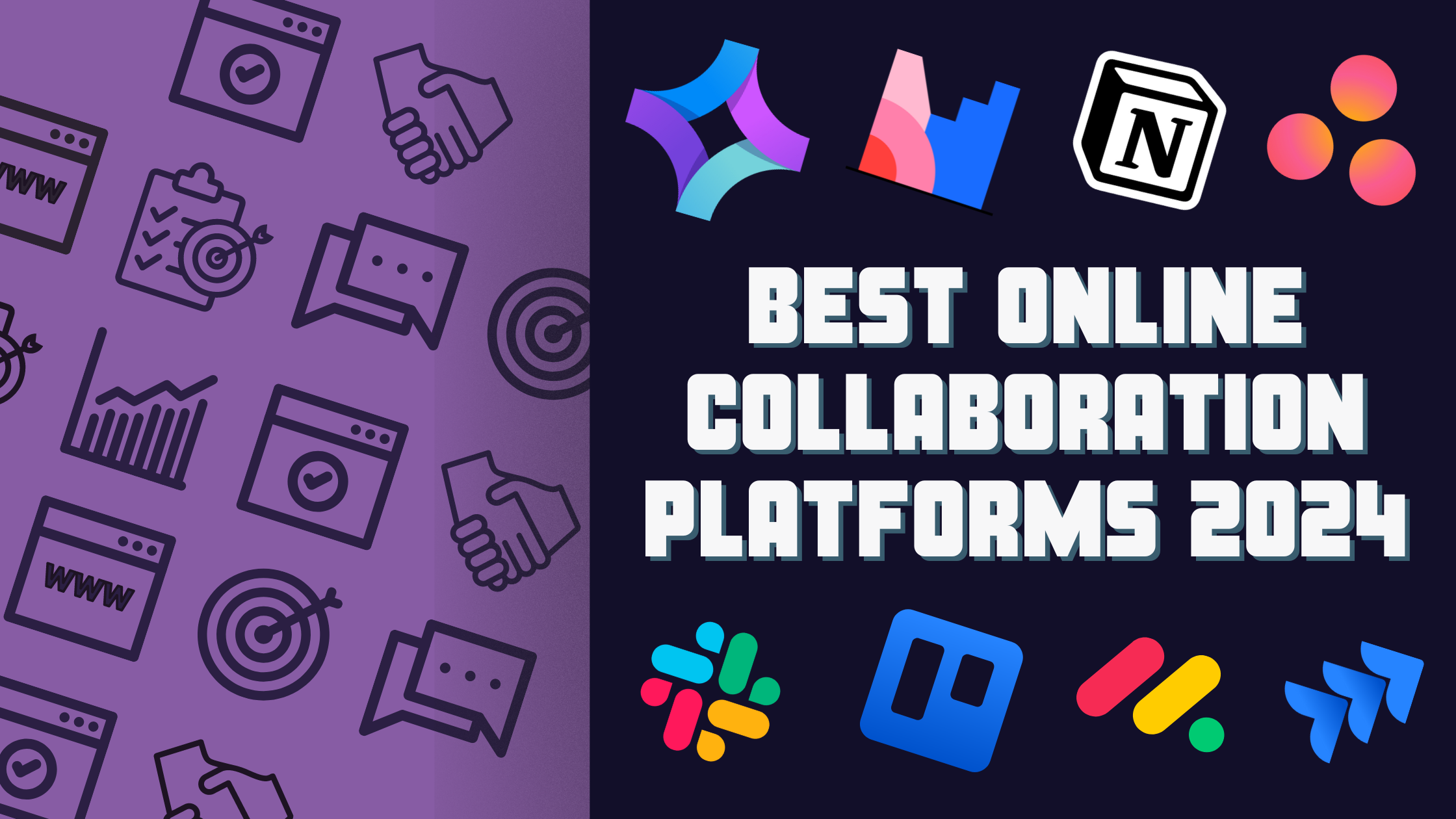It used to be that a decent email service and internal messaging system satisfied all your team’s communication needs. Not any more, especially with the advent of remote work and hybrid office models.
Effective collaboration platforms that offer the ability to communicate remotely across various media are now a must. And with so many available, making the right choice for your organization is crucial.
In this guide we analyze the different types of online collaboration tools, which features to prioritize, and which you can try for free. But first, let’s take a look at how using the best online collaboration software can help your team reach new heights.
Table of Contents

What Can Collaboration Platforms Do for You?
Not to put too fine a point on it, pretty much everything, as long as you choose the right one for your needs. At their most basic, collaboration platforms connect teams remotely for an efficient workflow irrespective of location or timezones.
In practice, modern team collaboration tools fulfill a variety of needs. Some excel in real time communications, others offer advanced project management features, others still focus on video-calling. The best collaboration platforms offer all of this, and a little bit extra, allowing teams to work together 100% digitally, using multiple media, tools, automation processes, workflow and task management systems and so much more.
Let’s dive deep into the top 10 collaboration platforms and project management tools for startups currently available on the market, to explain exactly how these can help your organization.

Best Collaboration Platforms for 2024
Not all collaboration platforms are created equally. While each offers a basic level of communication options, these may not always deliver the 360-degree package to cover all your team’s needs. Below, we analyze the standout features and shortcomings of some of the most popular virtual collaboration tools.
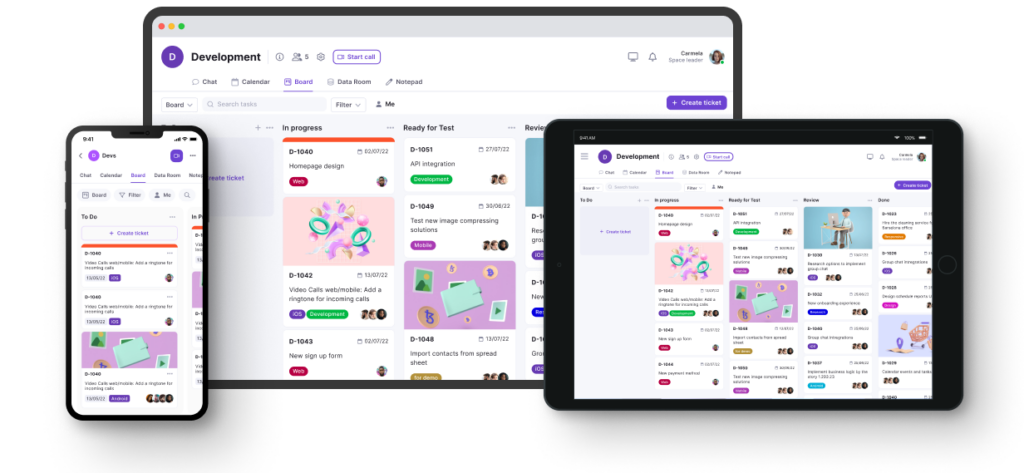
Teamplate – An All-In-One Solution
Teamplate has fast built a reputation for being the king of collaboration platforms thanks to an innovative approach where all essential remote team communication tools are integrated into one, highly-advanced solution. The tool poises you for success by unlocking high-performance features to take teamwork to the next level.
Features include chat, video calls, task and project management, Kanban board, calendar, a data room, recording features, email and anything you can think of to facilitate internal and external communications. This is all done from a single, intuitive hub that was conceived specifically with the aim of creating easy-to-manage and sustainable workflows.
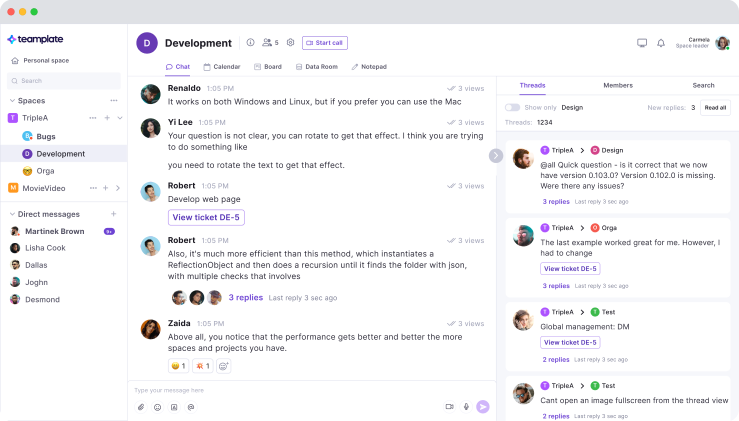
Standout Features
- Instant communication via chat
- Crisp, unlimited video calls
- Screen recording
- A Kanban-style task management system
- An integrated calendar
- A secure Data Room
- Spaces for teams to categorize projects, clients and other ventures.
- A personal space for each team member
Excellent for: Any organization looking for a comprehensive collaboration platform that includes every single tool in one, centralized hub – all for free.
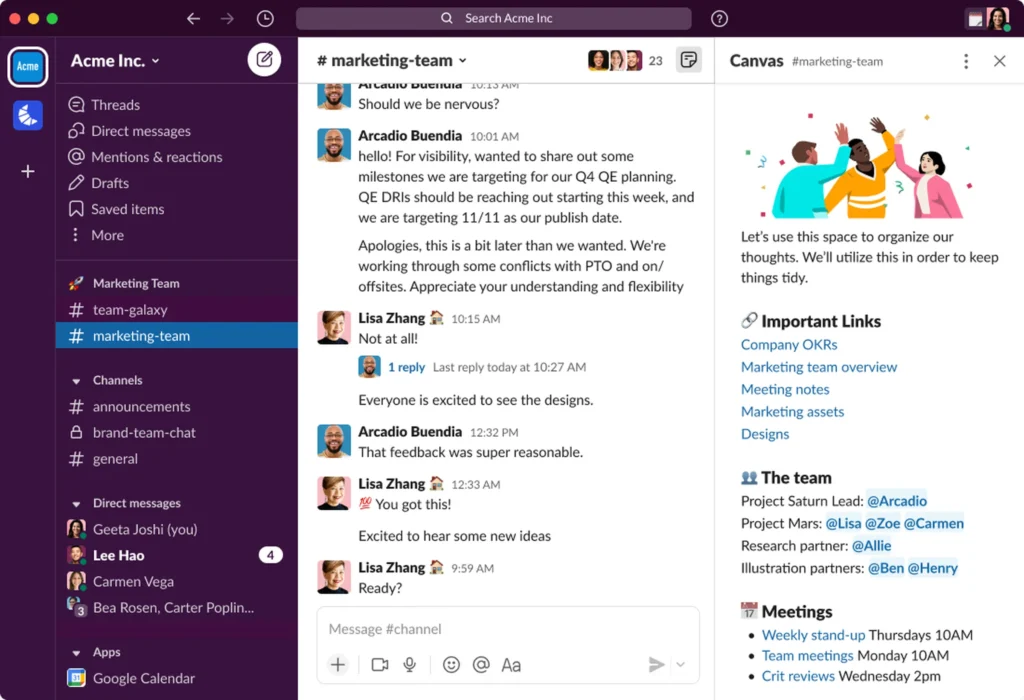
Slack – A Focus on Messaging
If you’re looking for collaboration platforms that are mostly limited to messaging, Slack is a good contender. It can be as casual or as organized as the team prefers, with the options of adding channels, video and voice calls, or to simply use it for one-on-one direct messaging.
While it’s not the most comprehensive of collaboration platforms, it can be helpful to keep the flow of communication organized and searchable thanks to the archive. However, you’ll need other software apps like Teamplate or Monday.com to execute other collaborative processes like project management.
Standout Features
- Threaded conversations
- Customizable notifications
- Advanced search and filters
- Shared channels
Disadvantages
- No task management
- Very basic video conferencing features
- Lacks document collaboration
- Poor handling of large-scale conversations
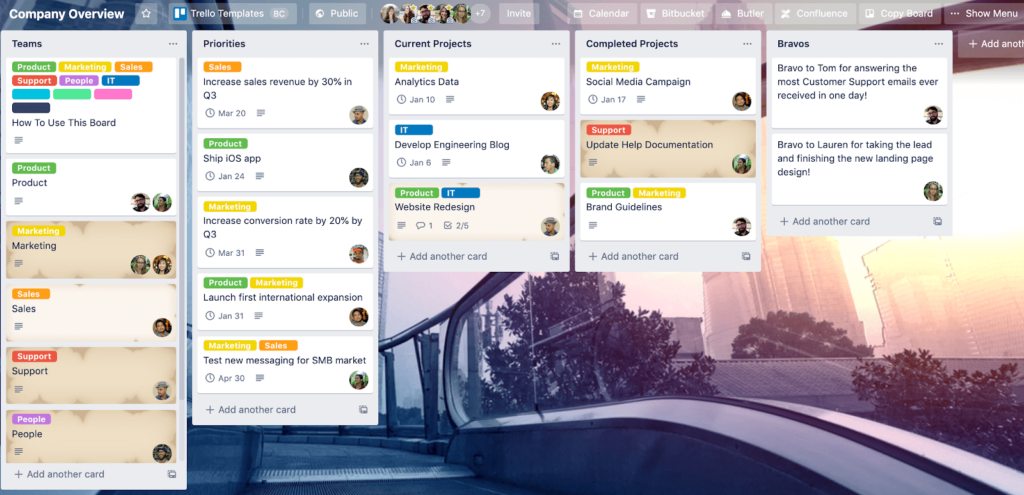
Trello – A Good Visual Aid
This visual project management tool helps you organize tasks and projects using boards, lists and cards. Boards are used to represent different projects, while the lists define workflow stages and cards track individual tasks.
All tasks can be customized thanks to features like checklists, attachments, labels and due dates so as to directly assign them to team members. While offering an excellent way to visualize all team tasks, that’s as far as Trello will take you as there are no advanced management features like those on Jira or Teamplate.
Standout Features
- Card custom fields
- Advanced checklists to break down tasks into subtasks card templates
- Supports attaching files up to 250MB directly to cards
- Tracks all changes and updates made to cards in an activity log, providing a detailed card history
Disadvantages
- Email and real-time messaging
- Built-in time tracking
- Native document collaboration
- Limited notification controls
- Very basic task dependency tracking
- No built-in Gantt charts
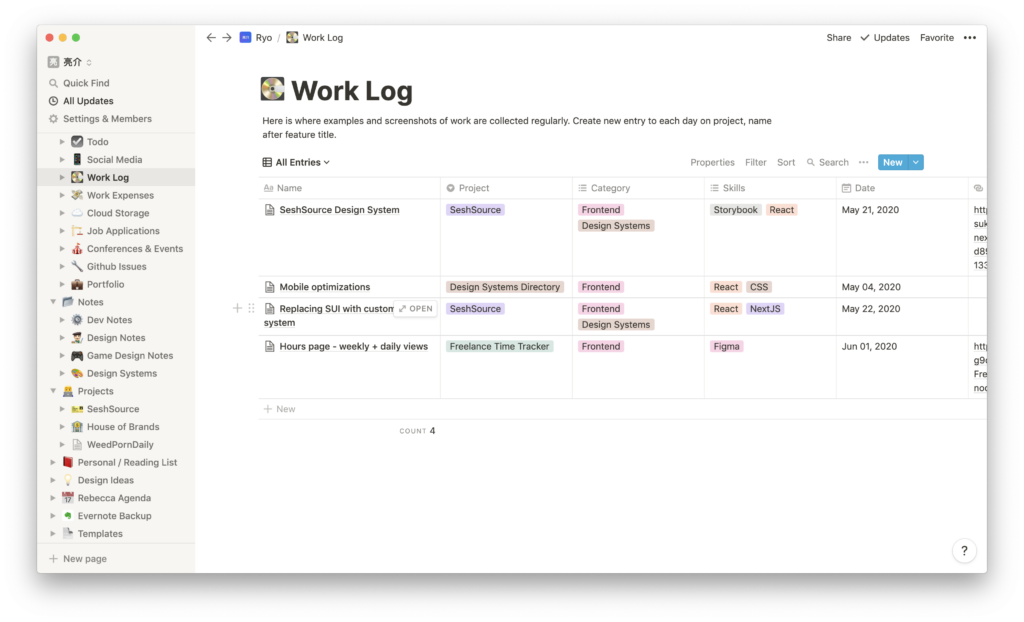
Notion – An Office ‘Wiki’
Notion is the ultimate, advanced ‘note taking’ app, offering a space where your team can write, plan and organize tasks in a database. You’ll be able to create custom databases like boards, lists and calendars with various properties like dates, tags and checkboxes to support the workflow.
You can create an unlimited hierarchy of pages within pages, all with different types of content blocks for a highly organized and detailed workspace. However, as collaboration platforms go, you won’t be able to communicate, oversee, plan and execute all your projects using this one tool. To do this, you’ll need a tool like Teamplate or Asana.
Standout Features
- Flexible database creation
- Nested pages and blocks: linked databases
- Integration with external apps like Google Drive, Slack and Trello
- Drag-and-drop page organization
Disadvantages
- No offline mode for real-time editing
- There are no detailed controls to customize alerts
- Built-in automation is not available
- Can be complex to learn
- There are limited permission controls within shared workspaces
- Can be sluggish when dealing with large databases

Zoom – Crisp Video-Calling
Zoom is one of those collaboration platforms that focuses heavily on one aspect of comms – video-conferencing. You will be able to hold virtual meetings and webinars while enjoying online collaboration through features like screen sharing, breakout rooms and chat.
The interface is very user-friendly, with participants able to join meetings with a simple link. The software carries out automated, real-time transcriptions of spoken content during meetings. This tool doesn’t go beyond conference calls, so you’ll need to use other software for crucial functions like project management.
Standout Features
- Breakout rooms
- Waiting room feature
- Webinar hosting capabilities
- Live transcription
Disadvantages
- No collaboration features
- Email integration is not available
- Thee are no built-in project management tools
- Messages are not threaded
- Screen sharing is very limited
Mentimeter – For Interactive Presentations
The main idea behind Mentimeter is the engagement of your team through live polls, quizzes, word clouds and Q&A sessions. Presenters can create dynamic content, with team members responding in real-time, making this one of the popular collaboration platforms for meetings, workshops and conferences.
The software facilitates active discussions by allowing attendees to submit questions anonymously. These can then be moderated and answered by the presenter, promoting an open and inclusive environment for feedback and discussion. However, it lacks the full spectrum of tools, in particular project management, offered by other collaboration platforms.
Standout Features
- Live polling
- Word clouds
- Audience Q&A
- Automatically reports results in easy-to-understand charts and graphs
Disadvantages
- No built-in video integration
- Very basic reporting analytics
- No annotation tools during a live presentation
- Limited question types for advanced assessments:
- Inability to link multiple presentations
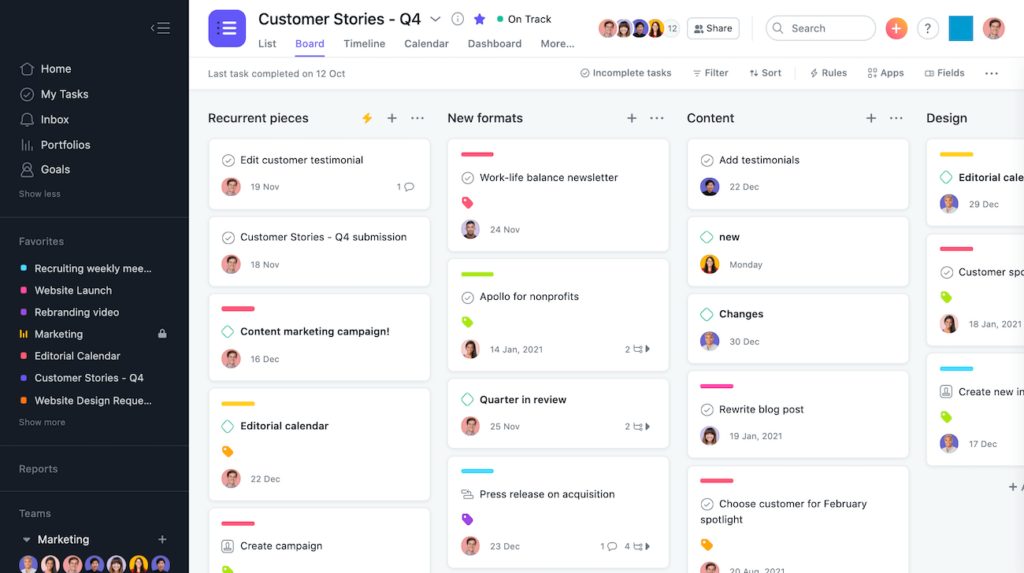
Asana – A Gantt-Like Approach
Asana helps your team organize, track and manage their work. You’ll be able to create tasks, assign them to team members, set deadlines, and monitor progress within various project views like lists, boards, and timelines.
Project planning is supported to a certain extent, with features like task dependencies, custom fields, and goal tracking. You can also connect different tools and simplify repetitive processes, although the automation features aren’t as extensive as those offered by some other collaboration platforms. Unlike tools like Teamplate, you won’t have access to email and calendar functions in one hub.
Standout Features
- Custom fields can be added to tasks
- Full task dependencies functionality
- Easy workload visualization for the whole team
- Goals and milestones tracking
Disadvantages
- Limited time tracking
- No native document collaboration
- No advanced dependency tracking features
- Limited customization of task views
- Lack of advanced automation triggers
- Limited subtasks visibility
- No built-in chat or direct messaging
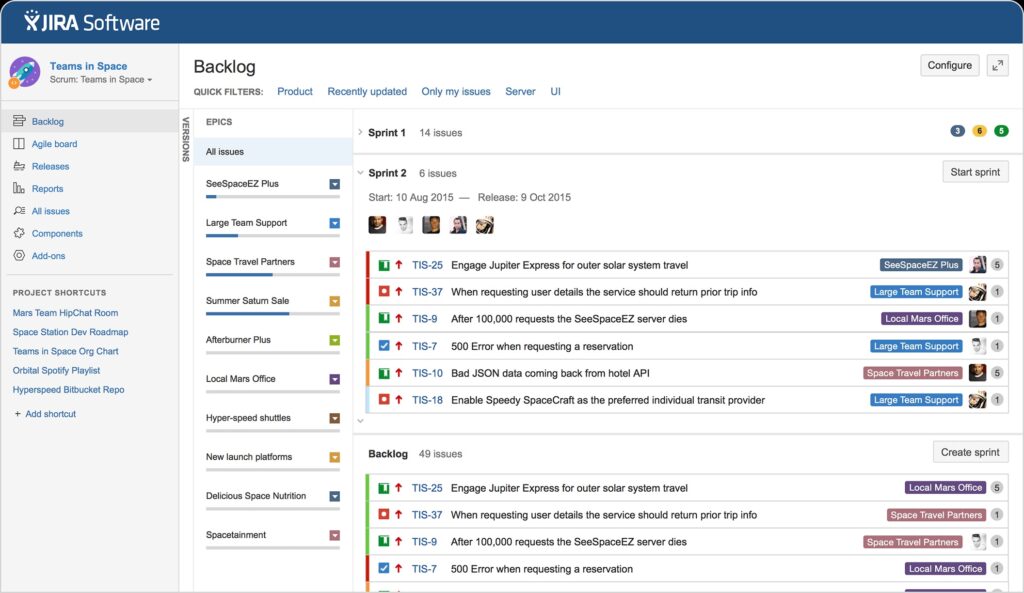
Jira – Agile-Friendly Methodology
Jira was designed primarily for software development teams to plan, track, and release projects efficiently. It offers a highly customizable workflow system, detailed issue tracking, and supports Agile methodologies while providing visibility into team progress.
It also gives administrators the ability to define access levels for different user roles, manage project visibility, and restrict actions like editing or deleting. However, compared to similar tools like Asana, it is not very intuitive and can require a steep learning curve for non-technical teams.
Standout Features
- Customizable workflows
- Agile boards, Scrum and Kanban style
- Detailed backlog management
- Granular permission controls
Disadvantages
- No built-in communication channels such as messaging or email
- Limited real-time collaboration
- Customization of reports requires in-depth knowledge of JQL (Jira Query Language)
- High dependency on third-party plugins
- Can be overwhelming
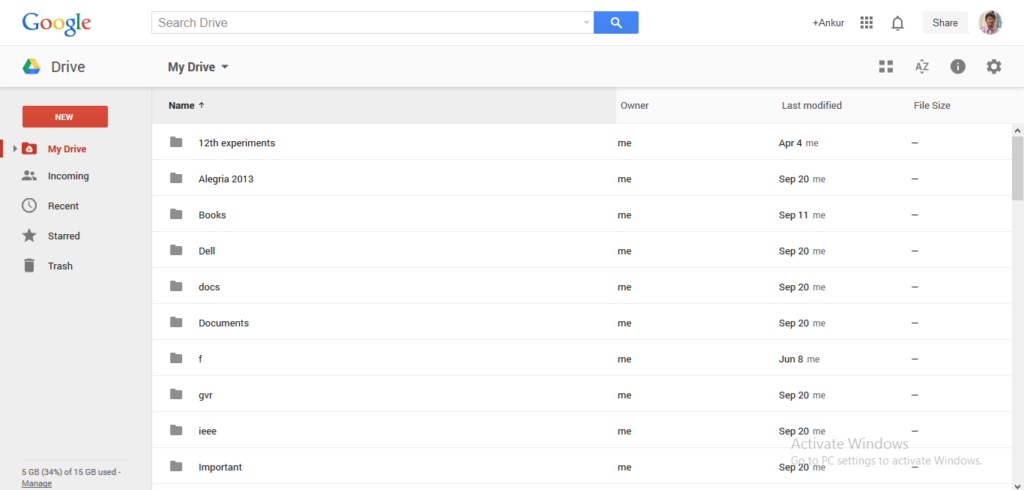
Google Drive – Cloud-Based Storage
Google Drive is a cloud-based storage and collaboration platform that allows your team to store, share and work on files from anywhere. Each member can work simultaneously on documents, spreadsheets, or presentations, with live cursor tracking and instant updates.
However, it lacks built-in project management features such as task assignments, progress tracking, or timelines, unlike other collaboration platforms like Teamplate or Monday.com, Moreover, files shared in Google Drive can become difficult to organize as they do not automatically follow a structured folder hierarchy when shared with others.
Standout Features
- Real-time collaboration
- File version history:
- Advanced sharing controls
- Integration with Google Workspace
Disadvantages
- Limited project management capabilities
- Very basic document formatting options
- No built-in chat for real-time discussion
- Fragmented organization of shared files
- No native workflow automation
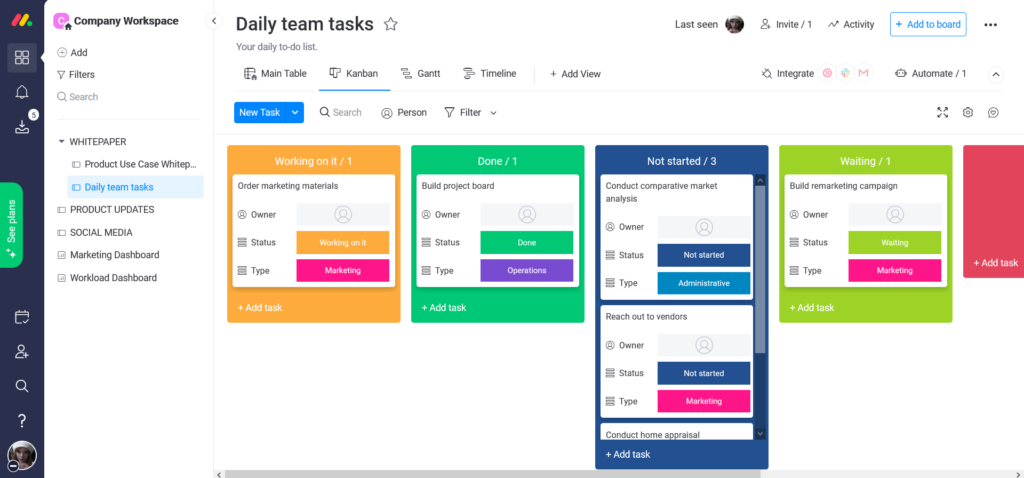
Monday.com – Flexible Work Management
Monday.com is a flexible work management platform that allows you to plan, organize and track projects using customizable boards. It’s noted for very powerful automations, allowing you to set up no-code rules for task assignments, notifications and workflow updates, so you can very easily streamline all your processes.
It has several shortcomings compared to other collaboration platforms like Notion, as it doesn’t allow for real-time simultaneous editing. Nor does it offer native email and messaging features like Teamplate.
Standout Features
- Fully customizable boards
- No-code automation capabilities
- Timeline and Gantt views
- Advanced reporting dashboards
- Integrations with external tools
Disadvantages
- No real-time collaboration
- No built-in time tracking
- Automations have a monthly usage cap
- No full subtask management and dependency features
- Very costly for advanced features like reporting, automations, and integrations
Best Collaboration Tools At A Glance
| Tool | Purpose | Top Features | All Features Free |
| Teamplate | All-in-one comprehensive workflow for remote communication | Centralized hub combining all forms of project management | Yes |
| Slack | Team communication a | Direct messaging | No |
| Trello | Task tracking | Drag and drop lists and tasks | No |
| Notion | Note-taking and project management | Customizable templates | No |
| Zoom | Video conferencing | HD video, breakout rooms | No |
| Mentimeter | Interactive presentations and polling | Live polls, Q&A, quizzes, word clouds | No |
| Asana | Project management and workflow | Task assignments and timelines, | No |
| Jira | Project management and workflow | Scrum boards, Kanban boards | Yes |
| Google Drive | Cloud-based document sharing | Real-time collaborative editing | Yes |
| Monday.com | Work management | Customizable workflows, dashboards, integrations | No |
How To Choose The Best Collaboration Platforms For Your Needs
When choosing your organization’s collaborative tools and software, you need to ensure that it satisfies all your team’s daily requirements without the need of any add-ons. The below are the essential features to look for.
- Task management: Allows you to create, assign, prioritize, and track tasks in an organized manner.
- Integration: Reduces the need to switch between different platforms.
- Secure web-based file sharing: You can upload, store, and share files in the cloud.
- Real-time communication: Offers instant updates, live collaboration, and immediate feedback, allowing team members to work simultaneously on tasks, documents, or projects without delays.
- Agile structure: Supports flexible and iterative work processes, such as sprints and backlogs.
- Asynchronous, effective communication: Allows your team members to communicate without requiring simultaneous presence. This is essential not only for different time zones, but also to respect different schedules and task priorities.
While many collaboration platforms like Google Drive, Trello or Jira hit some, or many of the above features, very few manage to satisfy them all.
Boost Your Team’s Performance With Teamplate
Teamplate offers all the above essential functions, including them as standard features that are intuitive and won’t require a learning curve or adjustment by your team. The added bonus is that you won’t need to pay any subscription fee.
If you’re done with collaboration platforms that miss out on crucial features, it’s time to discover Teamplate’s advanced capabilities for free. You’ll be gaining access to a comprehensive remote team communication software that includes all necessary tools to facilitate a smooth and efficient workflow, no matter what the size of your team or where each member might be located.
Test it out for free here.

